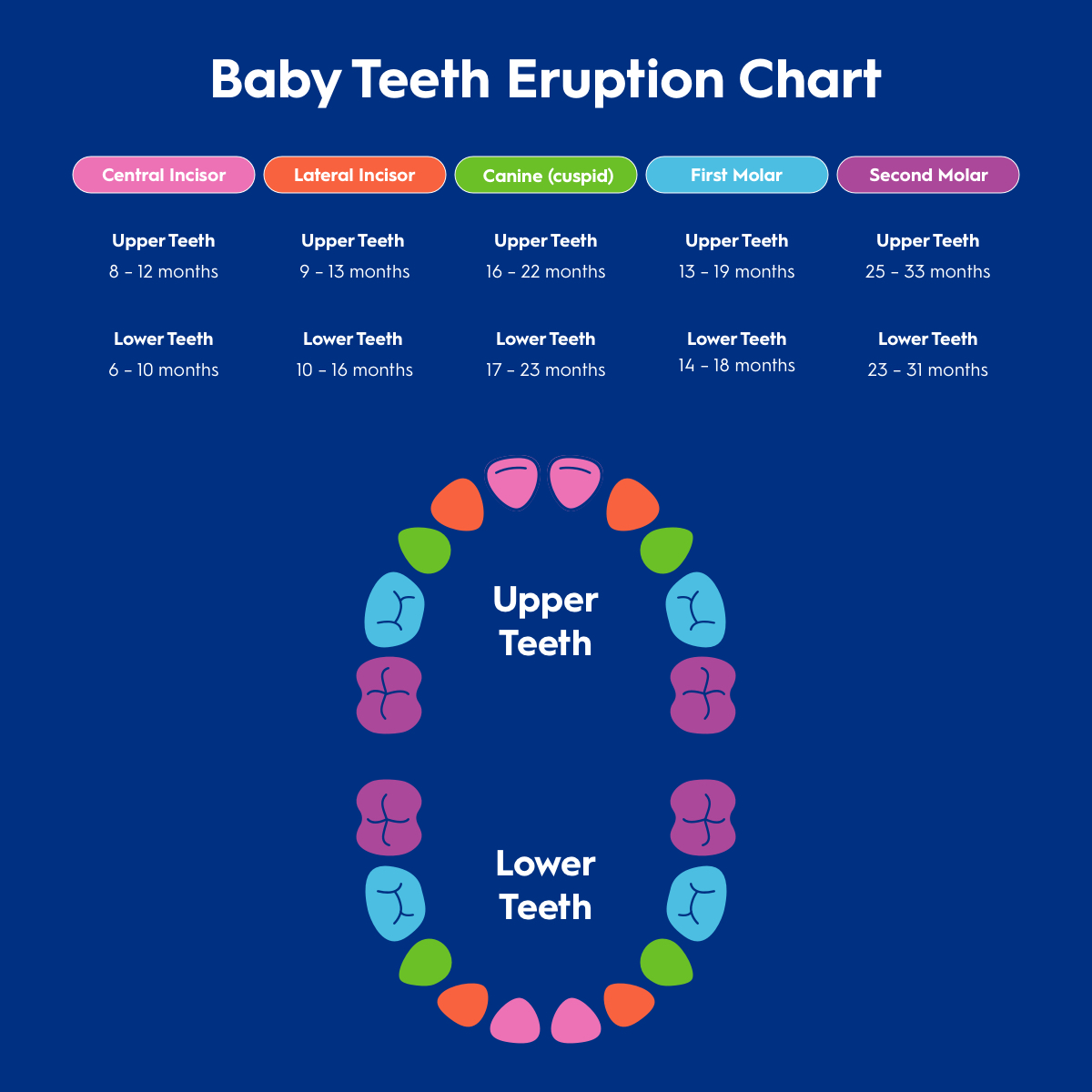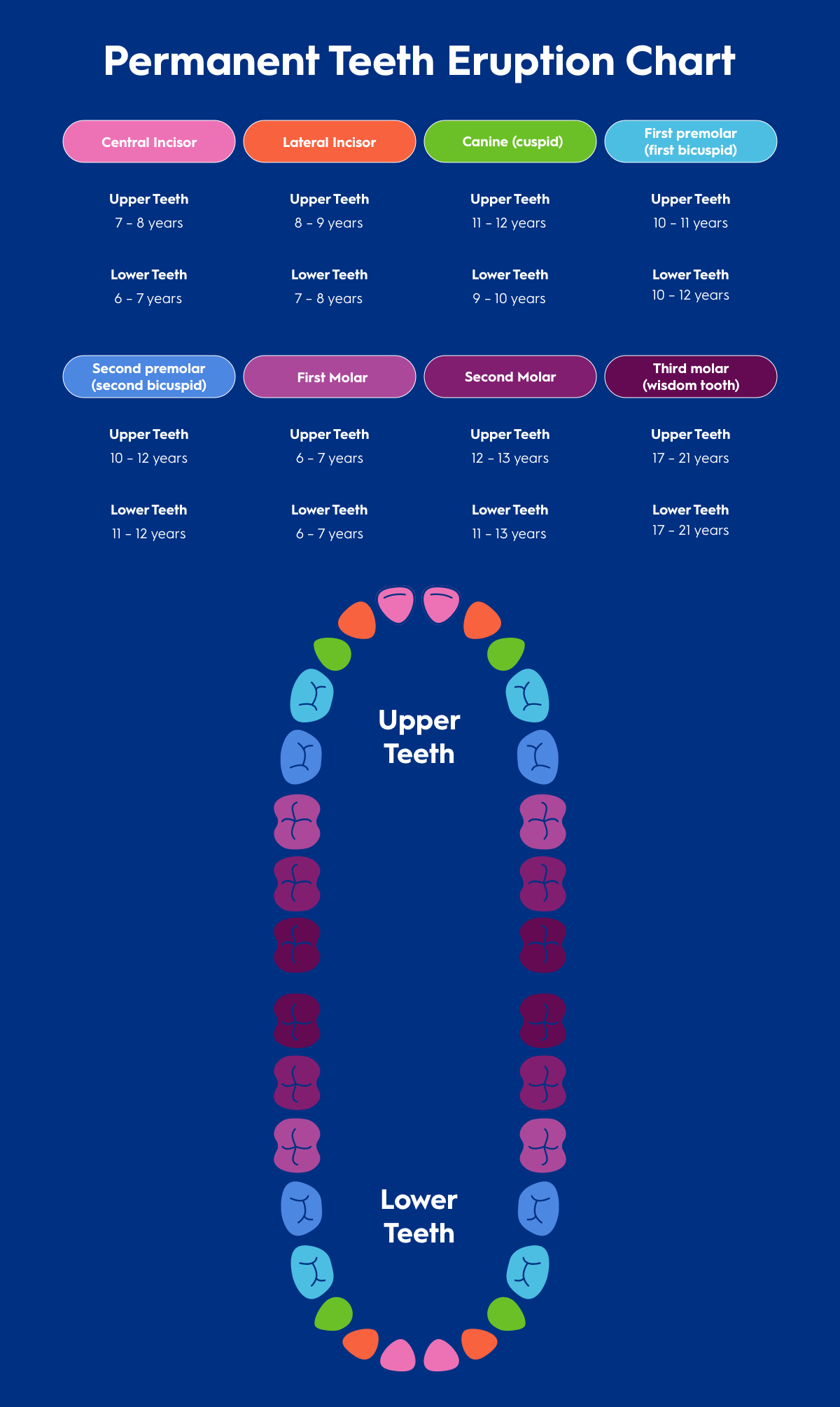Baby Teeth Eruption Chart

Summary
Key Takeaways
- The first primary or deciduous teeth to come in are the lower central incisors which typically occurs around 4 to 6 months of age
- All 20 baby teeth should be fully erupted by the age of 3
- Challenges during teething include fussiness, excessive drooling, sleep disruptions, and tender gums
- Soothe a teething baby by gently massaging gums, offering chilled teethers, and cool, soft foods
- Start brushing your baby's teeth as soon as that first tooth appears with a soft bristled baby toothbrush
Table of Contents

Approved and reviewed by Dr. Gans, a dental professional of over 10 years.
LEARN MORE >Key Takeaways
Baby teeth start to develop even before birth, but when do they actually begin to fill out your little one's smile? Get an overview of when you can expect to see those first pearly whites with our baby teeth chart.
Baby Teeth Eruption Chart

What to Expect During Teething?
Teething is a major milestone in your little one's development, but it's not without its challenges. As baby teeth, or deciduous teeth, begin to erupt from the gumline your baby may face some discomfort and changes to their daily routine.
Here's what to expect when baby starts teething:
- Extra drool: Your baby will produce more saliva during the teething phase. This can lead to teething or drool rash. Make sure to keep your little one's sensitive skin clean and dry during this stage.
- Fussiness: Crankiness and irritability go hand-in-hand with teething as your little one may experience some discomfort, specifically with their tender gums.
- Sleep disruptions: With less distractions to help take their minds off of their sore gums, teething babies tend to get fussier at nighttime.
- Tender gums: Teething gums are redder and more swollen in appearance and can be sensitive to touch.
- More chewing: Your baby may chew on more objects to seek out teething relief as they try to lessen some of the pressure on their gums.
How to Soothe a Teething Baby
Fortunately, there are a few soothing tips you can try to help your little one through this stage:
- Massage gently: Use a clean finger to softly rub along the gums.
- Offer a teether: A chilled, not frozen, firm teething ring with ridges that your baby can chew on, can help soothe their teething gums.
- Brush softly: Gently clean and massage your little one's gums with a soft-bristled baby toothbrush.
- Diet considerations: Cool, soft foods like yogurt and chilled water can help ease some of the discomfort.
- Visit a professional: Speak to your pediatric medical professional to see if over-the-counter pain medication, like acetaminophen, can help.
- Distract them: Distraction can work wonders for your little one! Take them to the park, read an exciting book, or play with their favorite toy to help take their mind off of teething symptoms.
When to Start Brushing Baby Teeth?
It is recommended that you start brushing your baby's teeth as soon as that first tooth erupts. Use an extra-soft bristled toothbrush to gently clean your baby's teeth and tender gums.
The Oral-B and Crest Baby Training Toothpaste and Toothbrush Kit features a manual toothbrush with extra-soft bristles for a gentle clean and a mild strawberry flavored toothpaste that's free of artificial flavors, sodium lauryl sulfate, sweeteners, and dyes.
Caring for Baby's First Teeth
Brushing baby, or deciduous teeth, is just as important as caring for adult teeth as they set the tone for a healthy foundation. Baby teeth are needed for speech development, eating, and jaw formation.
Follow these steps when caring for your little one's new smile:
- Gently wipe away plaque and bacteria from your baby's gums after each feeding with a damp washcloth.
- Gently clean baby's gums and teeth with a baby toothbrush equipped with extra-soft bristles.
- Visit a pediatric dental professional as soon as that first baby tooth comes in or by the age of 1 to make sure your little one's teeth and jaw are developing correctly. They may also offer personalized recommendations to help support a healthy smile for your baby.
When Do Adult Teeth Come In?
The first adult molars start to come in around age 6.
At this stage, it's important for them to brush with a fluoridated toothpaste for more plaque removal to better fight off cavities. Kids under 3 years old, use a small amount of fluoridated toothpaste, about the size of a grain of rice. For kids 3+, use a pea-sized amount of fluoridated toothpaste. ADA-approved Crest Kids Advanced Color Changing Toothpaste changes from blue to pink to help kids brush the dentist-recommended 2 minutes. Plus, it's the best protection for kids from Kid's Crest, the #1 kids' toothpaste brand in America.
By the time your child reaches the age of 13, most of their adult teeth should have fully emerged with the exception of third molars, or wisdom teeth. Expect those to appear during the late teenage years or early twenties.
Permanent Teeth Eruption Chart

How to Floss Kids' Teeth
Twice daily toothbrushing is key for a healthy mouth, but flossing is just as important and should not be overlooked as part of your child's daily routine. Start flossing your baby's teeth as soon as two teeth are touching one another.
Continue to floss your child's teeth for them until they're about 8 years old and are able to master the proper technique on their own.
- Gently glide the floss between two teeth.
- Form a “C” shape with the floss around each tooth.
- Gently slide the floss up and down against the tooth.
- Floss below the gumline to remove trapped plaque and debris.
- Use a fresh section of floss as you move across each tooth.
- Have them rinse and spit after flossing to remove any loosened plaque or leftover food.
Teeth Brushing for Kids 6+
The older they get, the more independent they want to be. And that includes daily toothbrushing. Part of big-kid brushing is taking responsibility for their own smiles, without (too much) prompting from parents.
Let your child take the reigns as they practice more independent brushing with the following steps:
- Have them brush twice a day for the dentist-recommended 2 minutes each brushing session.
- Upgrade to an electric toothbrush for kids ages 6+ for a clean which is tough on plaque but gentle on wobbly teeth—look for options featuring their favorite characters for some added encouragement!
- Show your child how to hold their toothbrush at a 45-degree angle to the gumline
- Let them glide, not scrub, across their teeth as the electric toothbrush does the work for them.
- Gently brush all teeth surfaces including the front, back, and chewing surfaces.
- Have your child brush for the full dentist-recommended 2 minutes with the 2-Minute Music Timer, you'll know they're done once the music stops!
- Gently brush their tongue to remove more plaque and keep their breath fresh.
- Reward them for a job well done!
To keep their growing smiles healthy and bright make sure to visit their dental professional at least twice a year for professional cleanings and checkups.
From Oral-B the #1 toothbrush brand used by dentists worldwide.
*BASED ON SURVEYS OF A REPRESENTATIVE WORLDWIDE SAMPLE OF DENTISTS CARRIED OUT FOR P&G REGULARLY.
Kid's Oral Care Recommendations
Complete Your Child's Oral Care Routine
- Brush your baby's tender gums and teeth with a soft-bristled toothbrush for baby ages 0-2 twice a day for two minutes each session.
- Switch to an electric toothbrush once your child is 3 to remove more plaque for healthy teeth and gums such as the Oral-B Kids Electric Toothbrush for kids ages 3+ featuring Disney and Marvel characters.
- Encourage healthy habits with the Disney Magic Timer App which helps kids brush up to 2X longer.
- Visit their dental professional twice a year for professional cleanings and checkups.
Equip your kids' oral care routine with the toothbrush, toothpaste, and mouthwash that's right for them.
FAQs
-
When does an infant start teething?
-
When do infants get their first teeth?
-
How to help teething gums?
-
What do you put on baby's gums when teething?
Sources
- https://www.cdc.gov/oral-health/prevention/oral-health-tips-for-children.html
- https://www.fda.gov/consumers/consumer-updates/safely-soothing-teething-pain-infants-and-children#:~:text=Soothing 20children's 20gums 20with 20prescription,gels 2C 20and 20homeopathic 20teething 20tablets
- https://kidshealth.org/en/parents/ teething.html
- https://my.clevelandclinic.org/health/ articles/11179-teething-teething-syndrome
- https://www.mouthhealthy.org/all-topics-a-z/eruption-charts
Table of Contents
- Baby Teeth Eruption Chart
- What to Expect During Teething?
- How to Soothe a Teething Baby
- When to Start Brushing Baby Teeth?
- Caring for Baby's First Teeth
- When Do Adult Teeth Come In?
- Permanent Teeth Eruption Chart
- How to Floss Kids' Teeth
- Teeth Brushing for Kids 6+
- Kid's Oral Care Recommendations
- FAQs
- Sources

Approved and reviewed by Dr. Gans, a dental professional of over 10 years.
LEARN MORE >
Sign Up
for expert advice and exclusive offers

Sign Up
for expert advice and exclusive offers


